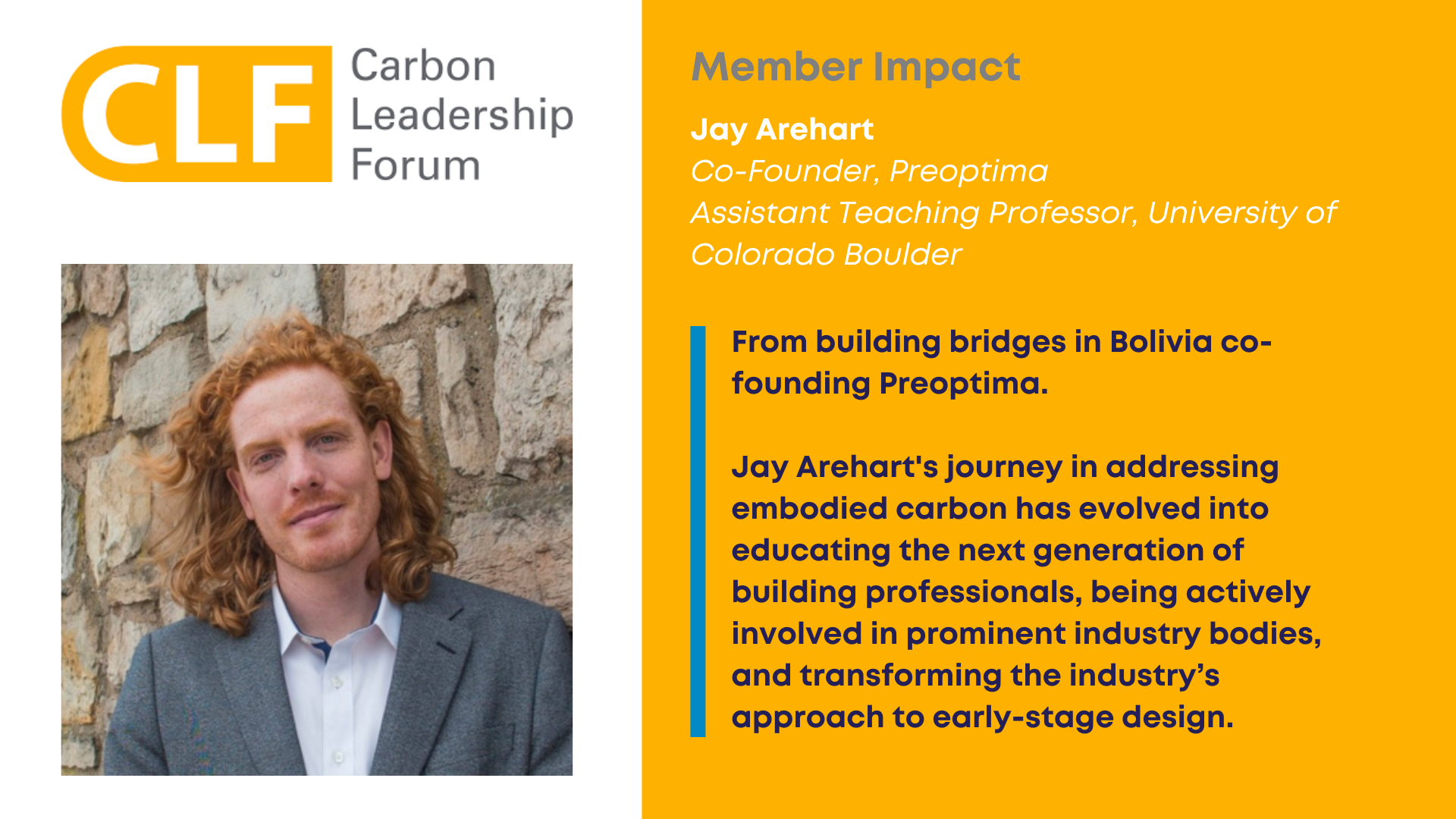Preoptima News | The Climate Journal
CLF Member Impact - Jay Arehart
Read Time 4 mins | Written by: Alex Bantock
From the rivers of Bolivia to the forefront of sustainable construction in the US, Preoptima's co-founder Jay Arehart, PhD's embodied carbon journey showcases how commitment and innovation can lead to meaningful environmental and industry impact.

The Carbon Leadership Forum (CLF) unites industry professionals in a shared mission to reduce the building sector's carbon footprint, focusing keenly on embodied carbon—"the greenhouse gas emissions arising from the manufacturing, transportation, installation, maintenance, and disposal of building materials." Among these professionals, Jay Arehart, co-founder of Preoptima, stands out for his innovative approach to sustainable building design and his commitment to education.
With the construction industry under pressure to meet the global climate targets outlined in the Paris Agreement, the need to address embodied carbon emissions has never been more urgent, and building professionals like Jay and the other members of the CLF are fundamentally changing how buildings are ideated, designed, and constructed to create "better buildings for a better planet" (CLF Tagline).
This month, Jay was featured in the CLF's Member Impact article, which highlights 4 noteworthy members each month. Learn about how Jay's work is contributing towards reducing embodied carbon below.
What are you and your organization doing to help reduce embodied carbon emissions?
Jay Arehart - Co-Founder, Preoptima Assistant Teaching Professor, University of Colorado Boulder
"I spent multiple summers during undergrad in Bolivia building pedestrian bridges over rivers that were impassable during the rainy season. It was during this time that I learned about how many Bolivians were becoming climate refugees. While I knew that I could become a structural engineer and minimize the embodied carbon of the systems I designed, I felt that it would be too incremental of an impact to help the people who would be most affected by climate change. Thus, I shifted my focus to becoming a teacher so that I can empower students and professionals to design low-carbon buildings. And for the past 8 years, I have been working on the embodied carbon problem from a couple of different angles.
I’m currently working with three organizations to help reduce the embodied carbon of buildings. I am a co-founder and chief product officer of Preoptima, a small startup building software to help design teams, developers, and code officials assess and reduce embodied carbon during the early stages of design. Our software enables rapid embodied carbon assessments so that the carbon implications of design decisions can be assessed to ensure that targets are met. Our first product, Preoptima CONCEPT is launching in early January of 2024.
I am also a teaching professor in architectural engineering at the University of Colorado Boulder. I weave topics of embodied carbon into undergraduate courses in addition to teaching graduate level courses on the topic of embodied carbon. I also offer courses on sustainable building design. The goal I have for my students is that they can join any design firm of construction company and hit the ground running accounting for and reducing embodied carbon. I am in the process of developing shorter, online courses and in-person workshops for professionals interested in earning an embodied carbon credential. In addition to teaching, I have a couple of ongoing research projects focused on how dynamic LCA can provide more detailed embodied carbon assessments.
And lastly, I am a co-chair of the Structural Engineering Institute (SEI) Sustainability Committee. Currently, our biggest focus is to develop a Prestandard that will create the standard of practice for assessing the embodied carbon of structural systems in buildings. Aimed to be published in the middle of 2024, the Prestandard will support the SE 2050 initiative and structural engineers everywhere in standardizing how to assess embodied carbon."
Addressing embodied carbon is a critical challenge that requires innovative solutions and dedicated professionals. Jay's work with the next generation of built environment professionals, his involvement in prominent industry bodies, and his founding role and continuing leadership at Preoptima collectively represent a significant contribution to this effort.
Jay, alongside Preoptima's other knowledgable co-founders and dedicated team, is shifting the industry's approach to early-stage building design with the power of real-time optioneering and whole life carbon assessments as early as conceptual design. This approach highlights the importance of carbon avoidance, ensuring that we save precious embodied carbon emissions from being released in the first place through carbon-efficient designs that have been optimised from the very start of a project.
Preoptima's role in this transition highlights the importance of tackling embodied carbon emissions head-on as part of the collective effort to mitigate climate change.
Get Early-Stage Assessments in Minutes!
We'd love to hear from you!

